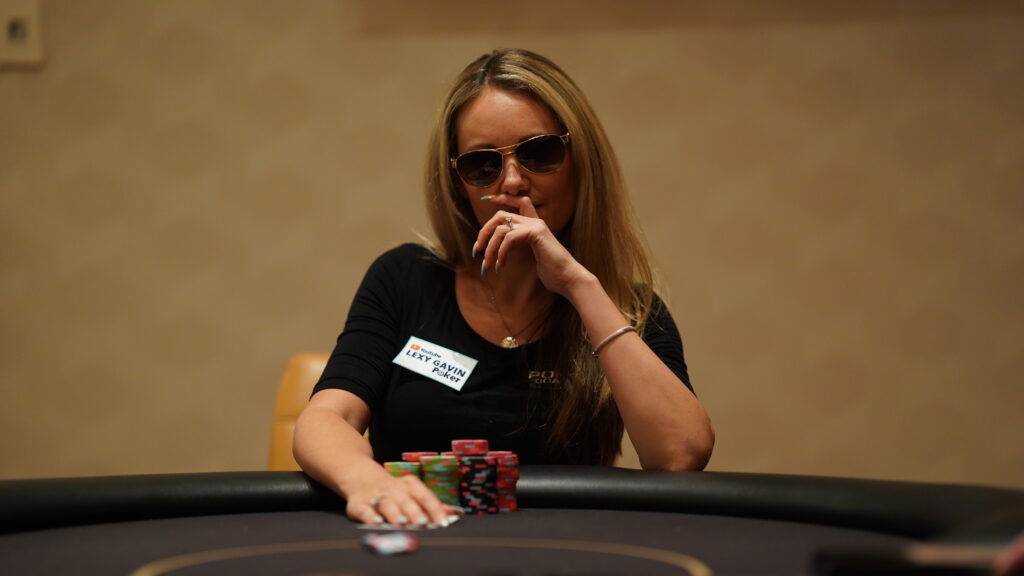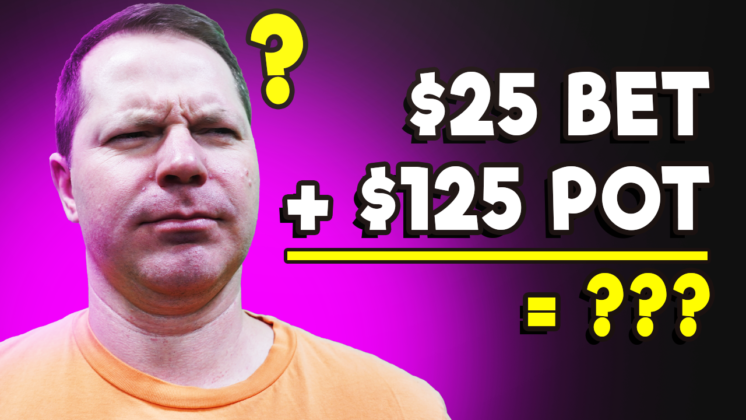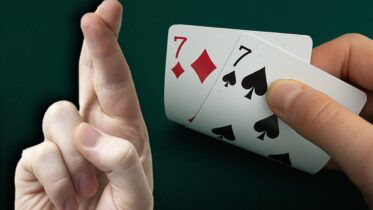Poker is a game of mathematics, regardless of what anyone will tell you, and pot odds are one of the most important concepts of poker rules and strategies.
Many poker players learn how to calculate their odds of winning the pot early in their careers but never quite bother to learn about the pot odds and how they impact the plays they should make.
In this guide, we are going to focus on pot odds specifically and teach you how to calculate them, when to use them, and how they will make your poker game better.
But, before we can get into any calculations or examples, let us first consider what pot odds are in the first place.
What Are Pot Odds in Poker?
So you have learned how to calculate your equity, and you may even know your odds with a flush draw or a straight draw by heart, but there is still a piece of the puzzle missing.
This missing part is the knowledge of pot odds, which tells you when you should or should not call particular bets made by your opponents.
In very simple terms, pot odds are the ratio of the pot size and the bet made by your opponent.
This ratio is the most important thing you will need to consider before making any call.
For instance, imagine playing in a low-stakes cash game in your local casino. With $30 in the pot, one of the other players shoots a $15 bet into the pot, a standard “half-pot” bet.
The question that many players now fail to ask themselves is what this bet means for them and whether they should call it or not, in mathematical terms.
The first thing you must figure out is the pot odds, which in this particular odds are 3/1. With $30 in the pot and another $15 your opponent bet, there is now a total of $45 in the pot.
You will need to call $15 to win a total pot of $60, which means you will need to win it once out of four times to break even. You can compare this number to your outs, and you will have a clear picture of where you stand in the hand.
Now, let’s talk a bit more about how we calculate pot odds for other bet sizes as well.
How to Calculate Pot Odds for Any Bet Size
There are many poker odds calculators, but the actual process of calculating pot odds at the table is quite a simple procedure, and professional poker players can do it without much thinking in most spots.
However, we are just getting started with pot odds, so let’s take the calculation one step at a time.
Step #1 – Calculating Pot Size
The first thing you must do when calculating pot odds is figure out the pot size. This may seem very simple, but players often forget to add their call to the final pot size.
The pot calculation should look like this:
Current Pot + Bet Size + Your Call = Pot Size
Once you add these three up, you will get the final pot size. In our earlier example, the calculation would look like this:
$30 + $15 + $15 = $60
Step #2 – Find the Bet to Pot Ratio
The next step in our process of calculating pot odds is also quite simple. You will need to divide the size of your bet with the total pot size.
In our example, this would be:
$15 (bet size) / $60 (total pot) = 0.25
Step #3 – Calculate the Percentage
The next step is even simpler. Multiply the ratio you got by 100, and you will get your percentage.
In our example, it would be:
0.25 x 100 = 25%
This number tells us the equity we need to have to make the call. In our example, we need to have 25% equity with our hand against our opponent’s range to make the call break even or better.
Step #4 – Estimate Your Equity
This is the hardest part of working with pot odds, and it has to do with actually putting them to use and making your decision based on them.
Once you know how much equity you need in a hand, you will need to figure out if you actually have this much equity against your opponent’s range of hands.
In our example, you would easily be able to make a call with a naked flush draw, which has about 35% equity against a made hand like an overpair. The call would be even easier with a hand like a flush draw with two overcards, etc.
Things get a bit trickier with made hands like the second pair or bottom pair, as the exact equity calculation is more difficult.
Quick Way to Know Your Pot Odds
As you can see, calculating pot odds is not the hardest thing in the world, and it will only require some simple math to get to the bottom of things.
However, having to actually do the calculations while playing can be a bit of a nuisance and time-waster, which is why it’s good to know some basic pot odds by heart.
Since most players make bets that fall into an approximate percentage of the pot size, here is a quick cheat sheet that tells you your pot odds for the most common bet sizes you might encounter:
| BET SIZE | EQUITY TO CALL |
| 25% Pot | 16% |
| 50% Pot | 25% |
| 75% Pot | 30% |
| Full Pot | 33% |
| 1.5x Pot | 37.50% |
| 2x Pot | 40% |
As you can see, the equity required to call even a 2x pot bet is just 40%, which means you may be folding too much to bets that are much smaller than this in your games.
However, keep in mind that you might also face further bets on later betting streets, which is why you should not always be counting on realizing your full equity in these situations.
On the other hand, you should also note that implied odds can play a part in your decision, as you could also end up making more money if you hit one of the cards that improve your hand.

Especially when playing live poker, calculating pot odds can be difficult, which is why consistent study of ratios is key!
Using Pot Odds in Play
Pot odds can be used in many different scenarios in poker. Anytime you are facing a bet, calculating your pot odds should be the first thing you do.
Before the flop, facing raises, 3-bets, or 4-bets, you will want to figure out your pot odds and think about how well your hand does against your opponent’s range.
On every other betting round, pot odds will help you decide whether or not to make a call, and your equity estimations could become even easier.
Let’s take a look at a couple of examples of how you can use pot odds in the game:
Example #1 – Preflop
You are playing a $55 online tournament. With blinds at 500/1k/1k, you are sitting on a 40k stack in the big blind, holding Qh4h. The player in the cutoff opens to 2k, and the other players fold.
Our hand is certainly not a monster, but if you have been paying attention to pro tournament players playing on TV, you have probably noticed that they call raises like this almost every time.
Why? Well, let’s do the math. First, we need to calculate the pot size:
1k (big blind) + 500 (small blind) + 1k (ante) + 2k (raise) = 4.5k
There is currently 4.5k in the pot, and we need to call 1k, making the full pot 5.5k. Now, let’s calculate the ratio and the pot odds:
1k/5.5k = 0.18
0.18 * 100 = 18%
You need 18% equity to make your call profitable. Considering the fact that Qh4h has over 16% equity even against AA and 36.45% equity against AK, our equity against any CO opening range is certainly over 18%.
In fact, you should be making this call even against an early position opener with this hand and many other, especially suited holdings.
It is worth noting that, when defending the big blind, you will be out of position for the entire hand, which will prevent you from realizing some of your equity.
That said, the price you are getting is way too good to miss out on, and you should always proceed with a call in a situation like this.
Example #2 – On the Flop
You are playing in a $1/2 cash game in a live casino. You call a $6 raise on the button holding 9s8s, and other players fold.
The flop comes 2c6s7d, giving you an open-ended straight draw.
Your opponent bets full pot for $15, and it’s your turn to act. Let’s go through the motions and first calculate the pot size:
Preflop: $1 (sb) + $2 (bb) + $6 (raise) + $6 (call) = $15
Flop: $15 + $15 = $30
With $30 in the pot, we need to call $15, which will make the total pot $45.
Now, we can use the simple formula we learned to calculate pot odds:
$15 / $45 = 0.33
0.33 * 100 = 33%
We need 33% equity to make this call, given the pot odds. With an open-ended straight draw and two overcards, we have a lot of cards that can improve our hand, but only eight that guarantee we make the best hand.
Using the rule of 2 and 4, we can quickly calculate that we have at least a 16% chance to hit our straight on the turn and a 32% chance to hit it by the river.
What’s even more, our overcards and backdoor flush draw give us extra equity, and we also have a lot of implied odds to consider if we make our hand.
Given all of this, the hand we have here is a candidate for both a call and a raise, but certainly never for a fold, despite the big bet size that our opponent used.
Example #3 – On the Turn
Playing in a $2/5 live cash game, you are sitting on a $1,000 stack in the big blind, and you look down at 7c6c. The cutoff raises to $12, the small blind calls, and you make the call as well, given the great pot odds you are getting.
The flop comes 2s4d8h, giving you a gutshot straight draw. SB and you check, and the CU leads out for $10 into the $36 pot. The SB folds, and given the pot odds you are getting, you make the call.
The turn is the Kd. You check, and your opponent leads for $80 into the $56 pot.
Should you make the call, the total pot would be:
$56 (pot) + $80 (bet) + $80 (call) = $216
You need to call $80 to win a pot of $216, so you need the following equity to make the call:
$80 / $216 = 0.37
0.37 * 100 = 37%
You need 37% equity to make the call. With your gutshot straight draw, you have about 8% equity to improve into a straight, and all your pair outs are unlikely to make your hand good.
This is a great example of when pot odds tell you to make the laydown, and you should listen to them. In fact, even if your opponent’s bet was quite a bit smaller, this would be a good spot to fold your cards and wait for a better situation.
Things get even simpler on the river with no more cards to come since you only need to compare your pot odds against the equity versus your opponent range. This way, you will always know if you should call or fold in any given situation.
Final Words on Pot Odds
Pot odds are one of the most important mathematical concepts in poker strategy, and fortunately, one that’s fairly easy to master.
Using the simple formula you learned today, you can calculate your pot odds and the equity needed to make a call in every situation there is.
However, keep in mind that simply knowing the pot odds won’t always be enough, as you will also need to learn how to estimate your equity against your opponent’s range, but that’s a lesson for another day.
For the time being, move forward calculating some simple pot odds and try going over some of your old hands and finding some spots where you should have made the call or folded according to pot odds but decided to go the other way.



